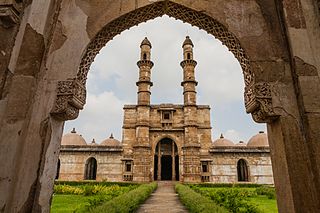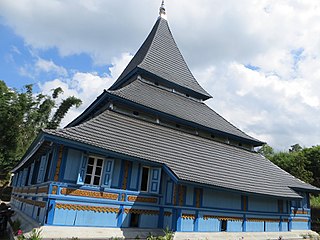
Riau is a province of Indonesia. It is located on the central eastern coast of the island of Sumatra, and extends from the eastern slopes of the Barisan Mountains to the Malacca Strait. The province shares land borders with North Sumatra to the northwest, West Sumatra to the west, and Jambi to the south, and a maritime border with the Riau Islands and the country of Malaysia to the east. It is the second-largest province in the island of Sumatra after South Sumatra, and is slightly larger than the nation of Jordan. According to the 2020 census, Riau had a population of 6,394,087 across a land area of 89,935.90 km²; the official estimate of population as of mid-2023 was 6,642,874. The province comprises ten regencies and two cities, with Pekanbaru serving as the capital and largest city.

Malay houses refer to the vernacular dwellings of the Malays, an ethno-linguistic group inhabiting Sumatra, coastal Borneo and the Malay Peninsula.

Kampung Laut Mosque is one of the oldest mosques in Malaysia. There is no confirmatory evidence when the building of the mosque took place. It is estimated to have been built sometime in the 15th century or 18th century. It is located in Kampung Laut, Tumpat District, Kelantan.

Kampar is a regency (kabupaten) of Riau Province of Indonesia. The regency formerly included a much larger part of Riau Province, but on 4 October 1999 the western districts were split off to form a separate Rokan Hulu Regency, and the eastern districts were split off to form a new Pelalawan Regency. It now has an area of 11,289.28 km2 and had a population of 688,204 at the 2010 Census, and 841,332 at the 2020 Census; the official estimate as at mid 2023 was 860,379. The administrative centre of the regency is located at the town of Bangkinang.

Baiturrahman Grand Mosque is a mosque located in Banda Aceh, Aceh, Indonesia. The Baiturrahman Grand Mosque is a symbol of religion, culture, spirit, strength, struggle, and nationalism of the Acehnese people. The mosque is a landmark in Banda Aceh and has survived the 2004 Indian Ocean earthquake and tsunami.

The Indonesian island of Sumatra is the sixth largest island in the world. The rich ethnic diversity and historical heritage in Sumatra is reflected in the range of architectural styles in the island. The vernacular style is the native Sumatran ethnic groups architecture of dwellings, while the Hindu-Buddhist architecture reflected through the cultural historical heritage of candis built in Sumatra. The third wave is Islamic architecture adopted in mosques and palace in Sumatra, especially in Aceh, North Sumatra, and Malay cultural sphere in the island.

Rumah adat are traditional houses built in any of the vernacular architecture styles of Indonesia, collectively belonging to the Austronesian architecture. The traditional houses and settlements of the several hundreds ethnic groups of Indonesia are extremely varied and all have their own specific history. It is the Indonesian variants of the whole Austronesian architecture found all over places where Austronesian people inhabited from the Pacific to Madagascar each having their own history, culture and style.

Jama Masjid, also known as Jumah Mosque or Jami' Masjid, is a mosque in Ahmedabad, Gujarat, India. It was built in 1424 during the reign of Ahmad Shah I. The inscription on the central mihrab commemorates the inauguration of the mosque on the 1st Safar A.H. 827 or January 4, 1424 A.D. by Sultan Ahmad Shah I. The mosque lies in the old walled city, and it is situated outside Bhadra Fort area. The old walled city is divided into separate quarters or pols, and the Jami' Masjid is found on the Gandhi Road. Along the south side of the road, the mosque is a short distance beyond the Teen Darwaza or Tripolia Gate.

Jami Masjid in Champaner, Gujarat state, western India, is part of the Champaner-Pavagadh Archaeological Park, a UNESCO World Heritage Site, and is among the 114 monuments there which are listed by the Baroda Heritage Trust. It is located about 150 feet (46 m) east of the city walls (Jahdnpandh), near the east gate.

Wapauwe Old Mosque is a historic mosque in Kaitetu village, located in the Wawane Mountains on the north part of cape Keitetu, Maluku, Indonesia. Established in 1414, it is the oldest mosque in the Moluccas and possibly the oldest mosque in Indonesia which has been maintained in its original state.

The Great Mosque of Malang is a mosque located in Malang, Indonesia. The mosque was built in 1890 and completed in 1903, making it one of the oldest mosques in Indonesia. The mosque is square-shaped, constructed with steel, and has a tajug on top. The original building is still maintained today.

Rao Rao Mosque is one of the oldest mosques in Indonesia located in Nagari Rao Rao, Tarab River, Tanah Datar Regency, West Sumatra. It is located on the road from Batusangkar bound to Bukittinggi, precisely in Rao Rao. This mosque of Minangkabau and Persian architecture was built in 1908 with a roof made from fibers before being changed to zinc.

The Bingkudu Mosque is one of the oldest mosques in Indonesia. It was founded by the Padri in the wake of the Padri War in West Sumatra in 1823. This mosque with typical Minangkabau style architecture is located in Jorong Bingkudu, Nagari Canduang Koto Laweh, Canduang District, Agam Regency, West Sumatra. When it was first built, the building of the mosque was made of wood on its floor, pole, and wall.

Jami Mosque of Taluak is one of the oldest mosques in Indonesia, located in Taluak IV Suku Nagari, Banuhampu District, Agam Regency, West Sumatra. The location of the mosque is close to the border of Bukittinggi, thus it is also known as Jamik Taluak Mosque Bukittinggi.
The Al-Mansur Mosque is one of the oldest mosques in Jakarta, Indonesia. The mosque is located at Jembatan Lima, Tambora, Jakarta. The mosque is one of the listed cultural heritage of Jakarta. The mosque is named after Kh. Mohammad Mansur who is familiarly called Guru Mansur- a Betawi figure known for his fight against Dutch colonial rules.

Masjid Jami Kampung Baru Inpak, also known as Masjid Kampung Baru or Bandengan Mosque, is one of the oldest mosques in Jakarta, Indonesia. It is located at Jalan Bandengan Selatan, Pekojan, Tambora, Jakarta, close to Masjid Al-Anshor. It is one of the mosques that was built by Muslim merchants from India who used to travel to and live in Batavia. The mosque has been designated as cultural heritage by the provincial government of DKI Jakarta.

Manonjaya Great Mosque is one of the oldest mosques in Tasikmalaya Regency, Indonesia. It was completed in 1837 with an area of 1250 square meters. Together with the Great Mosque of Sumedang, the government established the mosque as a paramount cultural heritage of Islam in 1975. The government's decree was issued by the Archaeology Board of Indonesia, which referred to the Antiquities Law on 1 September 1975.

Mosque architecture in Indonesia refers to the architectural traditions of mosques built in the archipelago of Indonesia. Initial forms of the mosque, for example, were predominantly built in the vernacular Indonesian architectural style mixed with Hindu, Buddhist or Chinese architectural elements, and notably didn't equip orthodox form of Islamic architectural elements such as dome and minaret. Vernacular architectural style varies depending on the island and region.

Grand Mosque of Kubang Putih is an early 19th-century mosque located in the town of Kubang Putiah, West Sumatra, Indonesia. The mosque is designated as a cultural heritage object along with several other old mosques in West Sumatra, such as Bingkudu Mosque in Agam, Rao Rao Mosque in Tanah Datar, and the Ganting Grand Mosque in Padang.

The Patimburak Old Mosque is a mosque located in Kampung Patimburak, Kokas District, Fakfak, West Papua, Indonesia. The oldest mosque in Fakfak Regency, the mosque is one of the historical legacies of Islam in Papua and has become one of the centers of Islam in Fakfak Regency.





























